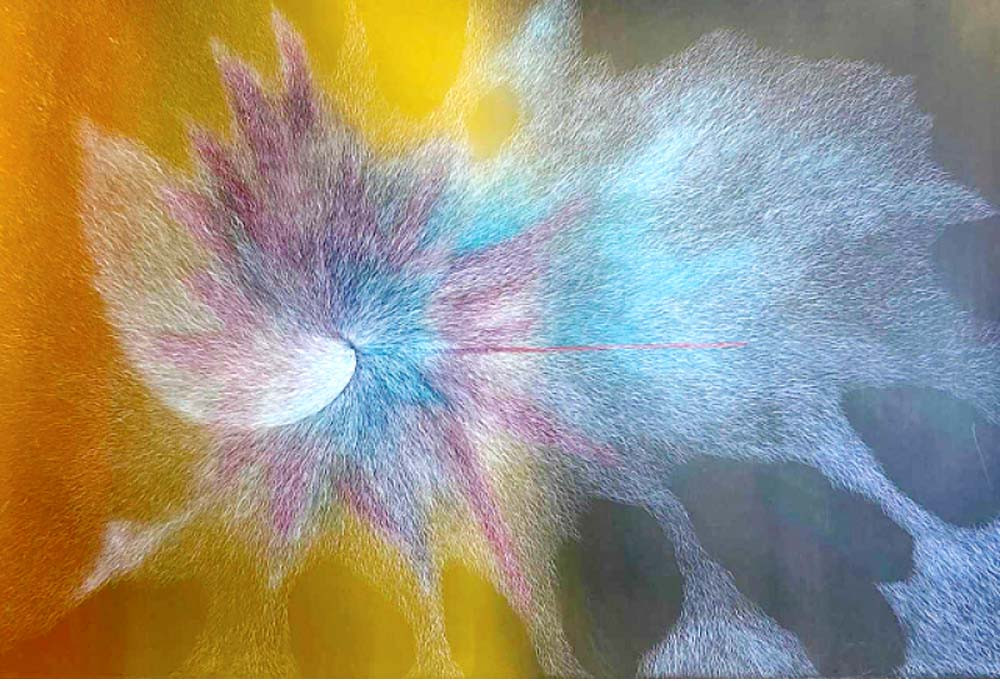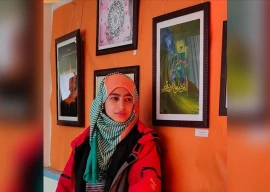
In his current solo show at Chawkandi Gallery, Rahim Baloch reiterates his communion with nature in twenty large format miniatures rendered in gouache on wasli paper. His signature motifs, namely the dandelion flower head and seed and - that loyal companion of flowers - the honeybee, play a primary role in portraying his mood. One might say his art is expressive of "flavor" or rasa that plays an essential role in the appreciation of classical music.
Like soft whispers, fine strokes of paint radiate from a central point towards the edges of the paper. The idea of tiny parachute seeds dispersing in the wind is expressed in the wave-like pattern of the strokes. In some works, the hexagonal grid of the honeycomb forms the backdrop. The large format of the paintings brings the viewer intimately close to the painted forms. The anatomical accuracy with which Rahim paints the honeybee is emphasized by close viewing. On the other hand, the subtle wave-like pattern of radiating strokes can only be discerned by viewing the paintings from a distance. As such, two types of viewing experience do the paintings justice. The artists encourages us to see the detail and then go beyond it in order to discern the patterns that are formed by the details.

Rahim's work expresses a philosophical stance that occupies the cusp of nature and metaphysics. He speaks of a rejuvenation of self that occurs at a point "where words are nothing anymore". The idea of nothingness is at the heart of the metaphysical content of his work. This is not a negative or nihilistic nothingness. It is a meditative void that beckons solitude and creativity. It is a liminal space where the artist can detach from worldly preoccupations in order to let the creative spirit take over.
Read More: Young Kashmiri artists seek to reinvent calligraphy
Rahim's paintings evoke an otherworldliness, of entering a zone that exists outside of chronological time. It is suggestive of an eternal realm that stands apart from the noise of human history. The symbiotic relationship of the honeybee and the flower represents this preternatural realm. A couple of paintings show a human figure that sits in the posture of a sage in the act of meditation. The figure seems to be crafted out of mist as if it is beginning to dematerialize and merge into the void. The human element is subordinated to naturalistic imagery to the point of seeming to acquire the attributes of nature.
Rahim depicts nature with great accuracy but the intention is far from a documentation of it. Rather, the figurative elements in his art become symbols for abstract ideas. The dandelion seed and the honeybee are metaphors for the idea of the source and the journey, the idea of the seeker and the search. They are the substance within an infinite void in which the search for meaning remains perennial, inexhaustible. Furthermore, they are lyrical symbols for a state of mind that is attuned to an intuitive understanding of the self. The timeless patterns of nature become the inspiration for the artist's inward journey from which he seeks rejuvenation.
Published in The Express Tribune, July 30th, 2021.



1719660634-1/BeFunky-collage-nicole-(1)1719660634-1-165x106.webp)

1732276540-0/kim-(10)1732276540-0-165x106.webp)






-1627290618-0/17-LEDE-(Main)-1627290618-0-270x192.webp)








COMMENTS
Comments are moderated and generally will be posted if they are on-topic and not abusive.
For more information, please see our Comments FAQ